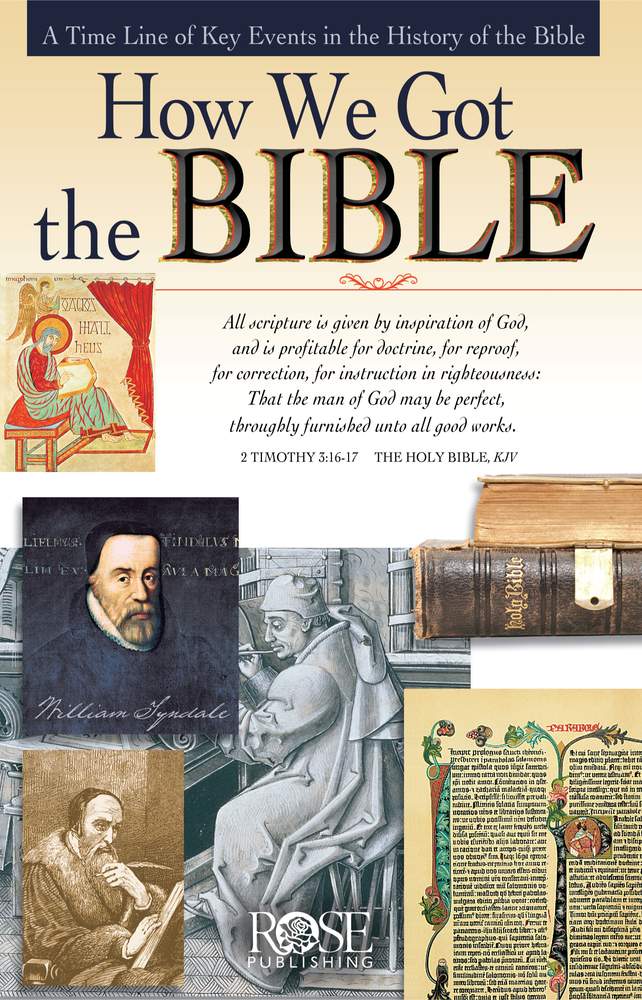HOW WE GOT THE BIBLE

HOW WE GOT THE BIBLE
Transcribed by Michael K. Farrar, O.D
“HOW WE GOT THE BIBLE by Rose Publishing.
(Please contact their website if you wish to purchase the full version of this pamphlet.)
2 Timothy 3:16-17
“All Scripture is inspired by God and beneficial for teaching, for rebuke, for correction, for training in righteousness; so that the man or woman of God may be fully capable, equipped for every good work.”
Major Points in History of How Our Modern Bible Came to Be
Point One
We need to begin with quoting from the Bible the major point that assures us that the Bible is the Holy Word of God, written by holy men of God inspired by the Spirit under the calling of God upon their lives.
The Scripture above (2 Timothy 3:16-17) is one passage that is important to us in explaining the source of the Bible another is 2 Peter 1:20-21;
“But know this first of all, that no prophecy of Scripture becomes a matter of someone’s own interpretation, for no prophecy was ever made by an act of human will, but men moved by the Holy Spirit spoke from God.”
Point Two
The Bible contains 66 different books that were written over a period of 1600 years (from approximately 1500 BC to 100 AD), by over 40 kings, prophets, leaders, and followers of Jesus Christ. The Old Testament has 39 books (written during the time period of approximately 1500-400 BC). The New Testament has 27 books (written during the time period of approximately 45-100 A.D.). The Hebrew Bible has the same text as the English Bible’s Old Testament, but divides and arranges it differently.
Point Three
The Old Testament was written mainly in the Hebrew language, with some portions in Aramaic. The New Testament was written in the Greek language.
Point Four
The books of the Bible were collected and arranged as well as recognized as inspired by God’s Holy Spirit and inspired as sacred authority by the councils of rabbis and councils of church leaders based on very meticulous and careful guidelines.
Point Five
Before the printing press was invented, the Bible was copied by hand. The Bible was meticulously and carefully as well as very accurately copied. This was accomplished by very special scribes who developed intricate accurate methods of counting words and letters to insure that no errors were ever made.
Point Six
The Bible was the very first book ever printed on the printing press with moveable type (Gutenberg Press, 1455, the Latin Bible).
Point Seven
There is much evidence that the Bible we have today is remarkably true to the original writings. Of the thousands of copies made by hand before 1500, nearly 5,900 Greek manuscripts from the New Testament alone still exist today. The text of the Bible is better preserved than the writings of Plato or Aristotle.
Point Eight
The discovery of the Dead Sea Scrolls confirmed the astonishing reliability of some of the copies of the Old Testament made over the years. Although some spelling variations exist, no variation affects basic Bible doctrines.
Point Nine
As the Bible was carried to other countries, it was translated into the common language of people by scholars who wanted others to know God’s Word. Today there are still 2,000 groups with no Bible in their own language. There are numerous Christian ministries who have committed themselves to translate the Bible into the languages of all people so that the Word of God can bring salvation and abundant life to all peoples of the World.
Point Ten
By AD 200, the Bible was translated into seven languages; by AD 500, 13 languages; by 900, 17 languages; by 1400, 28 languages; by 1800, 57 languages; by 1900, 537 languages; by 1980, 1,100 languages; by 2006, 2,426 languages have some portions of the Holy Scripture.
What material was used to write down the words of the Bible through history?
People wonder at times how the early copies of the Bible were written and what material was used to write the words of the Bible on? Early writing was done first on clay and stone tablets or leather. The New Testament Bible documents were written on “papyrus.” Papyrus is a material similar to thick paper that was used in ancient times as a writing surface. It was made from the pith of the papyrus plant “wetland sedge.” As time progressed “animal skins” became popular for writing the Bible. Fine quality animal skins come from calves or antelope (vellum) and sheep or goats (parchment) were used for over 1000 years to make copies of the Bible around AD 300-1400. Two of the oldest vellum copies (325-350) still exist today and are called the “Codex” and the “Sinaitic Codex.” Wycliffe Bibles were inscribed by hand on vellum in the 1300s -1400s. Some copies took two years to produce and a cost of a year’s wages.
When the Printing Press was invented (1455), this opened up a tremendous opportunity to make copies of the Bible available to the masses of people. The Bible was the first book to be printed with the Gutenberg’s printing press in 1455.
The Bible is now mass produced on paper in many translation versions and languages. It is also available in digital form on the internet and has also been verbally recorded so can be listened to on many modern computer devices.
(Source of above information came from: How We Got the Bible the Bible, Rose Publishing – For a complete version of this information
Please Contact Rose Publishing at the following website: https://www.hendricksonrose.com/)